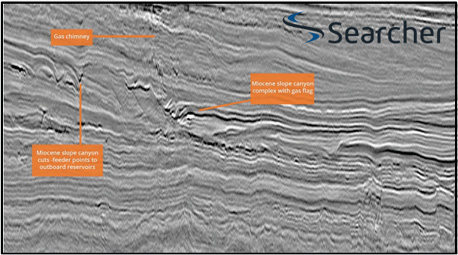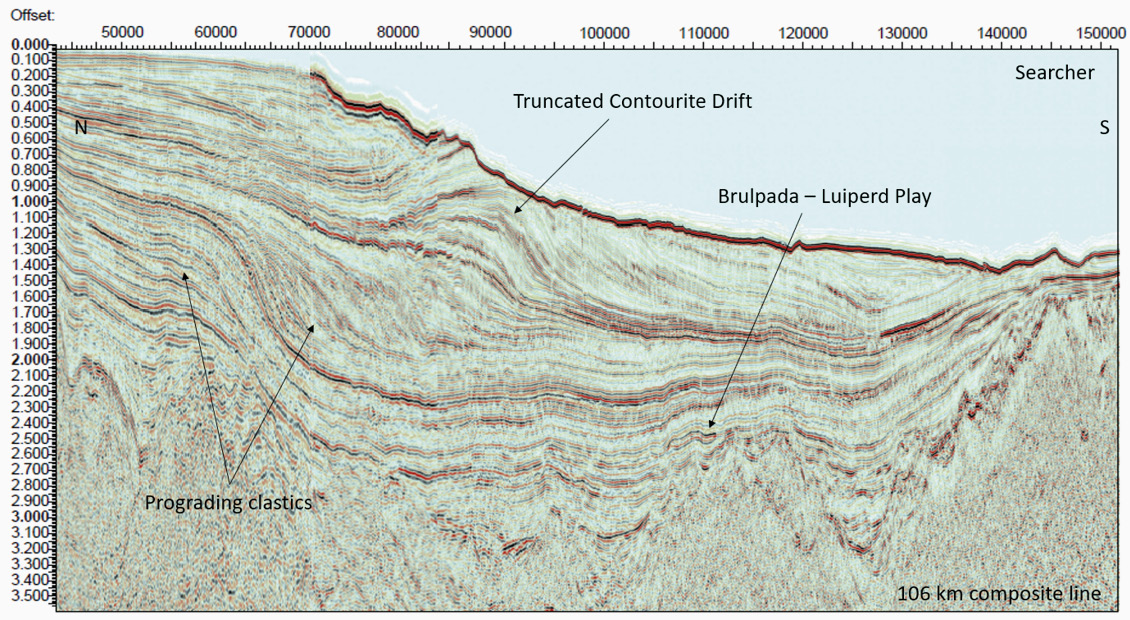Hybrid sedimentary systems develop where drift or coast parallel bottom currents interact with turbiditic or gravity-driven flow. There will be few places where this interaction doesn’t occur, but the dominance of one type of flow over the other is hugely variable around the margins of the world’s oceans and has been through time. In the oil and gas industry we have employed a default turbidite mindset to understand deeper water clastics for two main reasons, scale and sample bias.
Contourite and hybrid deposits have been studied for decades, for example Stow et al., 1998, Mutti et al., 1980, 2014, Rebesco et al., 2014 and Hernandez-Molina et al., 2008. Yet in the exploration world we did not have to embrace these concepts fully until recent discoveries forced us to bridge an enormous gap in deepwater sedimentology, between what is recognized at outcrop and what is observed on seismic data.
Hiding in Plain Sight
The effects of contourite systems on deepwater sediments can be subtle or even cryptic at outcrop scale. Deepwater shales, in particular, can look conformably bedded over hundreds of meters of outcrop. Slope channels may conceal the signs of contourite activity as they are dominated by basinward dip, incision and construction, and basin floor fans may have few current indicators to denote current flow direction on the basin floor. For this reason, global outcrops demonstrating clear contourite deposition are conspicuously rare in comparison to the number of examples visible on passive margin, regional seismic data. Either there is a problem preserving such margins in the outcrop record, or it is difficult to recognize them. Of course, explorers looking for coarse clastic reservoirs are also drawn to fluvial input points, where flow from slope to basin floor is often dominated by currents flowing downslope: turbiditic flow. This introduces a sampling bias, in that turbidite-dominated sequences appear to adequately characterize the deepwater geology that explorers have been concerned with, without the need for consideration of the influence of contourite currents.
However, in recent years the availability of high-quality regional scale seismic images has drawn attention to the frequent presence of contourite-dominated bedforms. This mismatch between seismic expression and field studies could perhaps have been swept under the carpet; however, several recent notable discoveries in contourite-dominated sequences have required a reevaluation of the importance of contourites’ influence on deepwater exploration models.
In a brilliant paper which catches the particular trapping style of the supergiant Coral gas accumulation, offshore Mozambique, Fonnesu et al., 2020, describe a number of ways that turbidite currents may interact with contourite currents to create new plays. On the left of Figure 1 (A), turbidites running down the slope (or across the basin floor) bump into contourite drifts, either depositing sand in the updip drift moat or causing the turbidite channel to meander around the drift. In the centre of the diagram (B), coarse-clastics move to the basin floor and deposit as fans, but these are redistributed by high-velocity bottom currents, creating isolated sand dunes (Mutti et al., 1980) and one supposes, migrating sand waves.
On the righthand side of Figure 1, (C), a contourite current interacts with a turbidite flow whilst it is running down the slope, stripping away the cloud of fine mud in the flow with which it builds the far levee (generating asymmetric levees), and/or new mounded or sheeted drifts offchannel, leaving currents in a constructional slope setting forces the channel to migrate laterally, setting up traps and seals. There are many excellent examples of this from many margins of the world, including offshore Mexico (Figure 2) and the Malvinas Basin in Argentina (Figure 3).
Spotting ‘Hybrids’ on Seismic
The identification of hybrid systems relies on the recognition of a series of diagnostic criteria derived from the integration of observations (Sansom, 2018). Yet, once you get your eye in, it is hard to interpret a deepwater regional seismic line without spotting contourite influence. There are several possible contourite manifestations that have been described due to the mixing of sediment input direction, slope and basin topology, clastic grain-size and orientation.
Visible in seismic sections are different styles of drifts; either mounded when they can be of giant size (Figure 4) and either isolated or nested, or drifts that are slope-leveed or sheeted (plastered, or abyssal). Drifts are commonly comprised of silt or shale and represent the resting place for the fine-grained material shed into a basin. In the example from Mexico shown in Figure 2, a fine-grained drift has been deposited over a basin floor fan creating a classic reservoir-seal pair. This relationship is also visible on Figure 4 in the South Outeniqua Basin of South Africa and has been reported in many other contourite-influenced margins.
What is less visible on seismic is the result of clastic sediment enhancement by winnowing of fine material from turbidity currents. To deduce the possible effect of these, we need to look for the channels that move against the current, driven by contourites building levees downdip. On the slopes of the Malvinas Basin, we observe constructional channel sand systems between large silt- and mud-rich drifts showing a distinctive crab-wise migration through time (Figure 3). In equivalent sequences in Rovuma, the quality of sand is particularly high in these drilled systems as the fines have been removed from the gravity flow and deposited around the channels as silt- and mud-rich levees and drifts.
These migrating channels (see Figure 1, C) are key in detecting the influence of contourites, and the winnowing of fines is the absolute product of this influence. A deposit of high sand content reflects more effective winnowing by contourite currents, which is often seen to be associated with a higher amplitude in the axis of the channel. Indeed, in the Tano Basin of Ghana, the tell-tale westward stepping stacking of channels in the Tweneboa, Enyenra, Ntomme (TEN) Field is due to contourite flow across the channel during deposition. The high quality of the sand in these channels will, at least in part, be due to this influence. Whereas in the past the sand content of the channel system may have been ascribed to the sand content of the sediment mix forming the turbidite flow, we now suggest that high sand content channels may have been enhanced by contourite activity, and lower net coarse-clastic content component channels have not.
This is interesting because contourite currents are not constant in time or constant down any given slope. Episodic activity through time reflects a variety of controls from the way oceans communicate, such as the opening of gateways to climatic controls such as atmospheric CO2. Variation in contourite strength and even direction downslope, reflects the stratification of oceans with depth into ‘slabs’ of water of varying density (defined as isopychnal units). Practically, it means that a turbidite being winnowed upslope may not continue to be winnowed downslope, or vice-versa. This complicates but does not preclude using the presence of contourite activity to correlate stratigraphically.
A common visualization of contourite coarse clastics, are prograding units on the basin floor that comprise contourite sand waves. These occur where high-energy currents cross the basin floor and interact with basin floor sand fans. They are so striking that often they have been interpreted as prograding deltaics, but they actually represent deepwater and ultra-deepwater sand deposits. The recognition of these sand wave bodies can be astonishingly fruitful for explorationists, as they are often very thick (500–700m offshore Uruguay) and having been winnowed and redeposited, may comprise sand-rich units.
Do Contourites and Mixed Systems Help Explorers?
Key examples of prolific discoveries associated with hybrid turbidite–contourite systems include the Rovuma Basin, offshore Mozambique (Mamba Complex 85 Tcf), the Tano Basin, offshore Ghana (Jubilee and TEN Fields), the Fan-1 discovery, offshore Senegal, the Tortue and Orca discoveries, offshore Mauritania, the Yakaar discovery, offshore Senegal and the Barra Complex discovery in the Sergipe Basin, offshore Brazil (Barra complex, 3 billion STOIIP). None of these accumulations could have occurred if these deposits had not been shaped by contourite currents. Hydrocarbon system elements analysis considers the presence, effectiveness and timing elements of source, reservoir, trap and seal. In this framework, the influence of contourite currents is particularly pertinent to reservoir effectiveness, trap and seal. Such analysis using regional seismic datasets, has led to the identification of a series of undrilled hybrid-system plays offshore Mexico, Peru, Argentina, South Africa and Papua New Guinea. The huge potential of these trapping systems indicates that this depositional system will now comprise a focus area for deepwater exploration globally.
Due to scale, sample bias and a lack of necessity, ‘hybrid’ turbiditic–contouritic sedimentary systems are only just beginning to be recognized as a significant new breed of exploration targets. Both, what can be seen on seismic (contourite influence bedforms) and what is inferred from contourite activity (winnowed turbidites yielding high net-to-gross sands in reservoir targets), is proving to be an essential tool in identifying these exciting hydrocarbon trapping systems.
References:
- Stow, D.A.V., Faugères, J.C., Viana, A., Gonthier, E., 1998. Fossil contourites: a critical review. Sediment. Geol. 115 (1), pp3–31.
- Mutti, E., Cunha, R., Bulhoes, E.M., Arienti, L.M., Viana, A.R., 2014. Contourites and Turbidites of the Brazilian Marginal Basins. AAPG Search and Discovery Article #51069.
- Mutti, E., Barros, M., Possato, S., Rumenos, L., 1980. Deep-sea Fan Turbidite Sediments Winnowed by Bottom-Currents in the Eocene of the Campos Basin, Brazilian Offshore. 1st IAS Eur. Meet. Abstr., pp. 114.
- Rebesco, M., Hérnandez-Molina, F.J., Van Rooij, D., Wåhlin, A., 2014. Contourites and associated sediments controlled by deep-water circulation processes: state-of-the-art and future considerations. Mar. Geol. 352, pp111–154.
- Hernández-Molina, F.J., Stow, D.A.V., Llave, E., 2008b. Continental slope contourites. In: Rebesco, M., Camerlenghi, A. (Eds.), Contourites, Developments in Sedimentology 60. Elsevier, Amsterdam, pp. 379–408.
- Atlas of deep-water outcrops, AAPG studies in Geology 56, Nilsen TH, Shew RD, Steffens GS and Studlick JRJ. 2007
- Fonnesu M., Palermo D., Galbiati M., Marchesini M., Bonamini E., and Bendias D.,2020. A new world-class deepwater play-type deposited by the syndepositional interaction of turbidity flows and bottom currents: The giant Eocene Coral Field in northern Mozambique. Marine and Petroleum Geology 111. pp.179-201.
- Bailey W., McArthur A. and McCaffrey W., Sealing Potential of contourite drifts in deep-water fold and thrust belts: Examples from the Hikurangi Margin, New Zealand. Marine and Petroleum Geology V 123, 2021.
- Sansom P., 2018. Hybrid turbidite–contourite systems of the Tanzanian margin. Petroleum Geoscience, 24, pp258-276, 29 June 2018
- Cronin, B. HGS/PESBG Africa 2019








